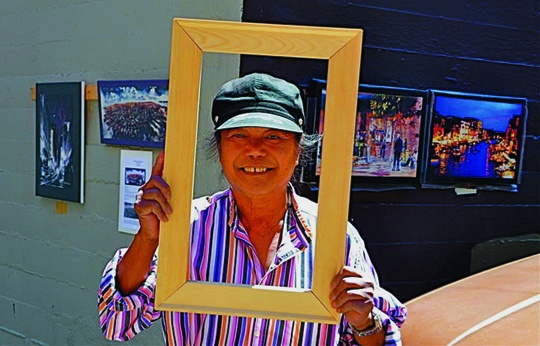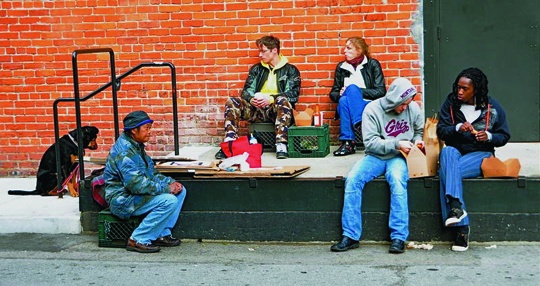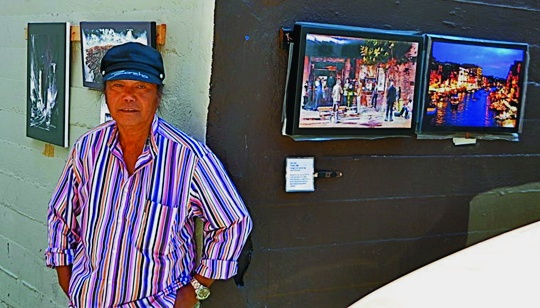
Robert L. Terrell
by Robert L. Terrell
[dropcap]I[/dropcap] recently interviewed the old man who lives with a large dog in a battered, old van on the south end of my block. He said he has been living in the van here in San Francisco for 10 years, and he has spent the past two of those years in this rapidly gentrifying South of Market neighborhood.
When I initially noticed him several years ago, he had two dogs. It took me several months to figure out that he was homeless, and additional months to ascertain that he lives in the old, gray van. At that time, he moved the van every couple days, but always within a radius of three or four blocks.
When he first arrived on this block, he continued his practice of moving the van every few days. But with the passage of time, the moves became less frequent. These days he rarely moves the van.
I assume the dogs liked this block, because they quickly became territorial, challenging anyone who walked too close to the parked van with hostile growls, bared fangs and frighteningly powerful lunges, held back only by a slender tether tied to the van’s battered bumper.
The weathered old man has obviously seen much better times. His gait is slow, his clothes threadbare and his body language suggests that he is slowly running out of energy.
During the two years he has lived on this block, I have never seen him visited by a relative, friend or acquaintance. And even though he is surrounded by hundreds of thousands of people, his is an extremely lonely existence.
When I plied him with questions about his future, his eyes darkened and his facial expression conveyed profound uncertainty. His is an interesting tale and I want to share some of it here. But I want to do so within context of the times in which we live, and the escalating tragedy unfolding in this nation regarding the deepening plight of people like the old man who lives with his dog in a van on the south end of my block.
Some segments of the national economy are recovering quite nicely from the recent Great Recession. Multimillion-dollar Wall Street bonuses are flowing again. The stock market is on an upswing, and the national economy is growing, albeit slowly.
Nonetheless, tens of millions of desperate people remain unemployed, millions of others have lost their homes, and numerous, grotesque forms of poverty are rampant throughout the nation.
In past eras when economic times were bad, those enduring the most desperate circumstances often took to the roads in search of better options in other places. Sometimes following rumors, and at others flowing in whatever direction they could go via a free ride, they attempted to escape from deprivation and economic despair in whatever ways they could.
Much of the drama, agony and heroism inherent in the most neglected portions of our nation’s contested history is composed of personal sagas associated with such treks. The wagon trains, the trails of tears, the runaway slaves, the leaving stories involving small towns and farms, the Dust Bowl refugees, the pioneers, the mail order brides, the gun-for-hire guys, and all the approximate, woebegone sagas so very frequently associated with them, are all tied together in one way or another by economic desperation.
Those who were brave, strong and resilient always had better options during such times than those who were very young or very old, weak and indecisive.
On more occasions than most U.S. citizens are willing to acknowledge or contemplate, economic desperation has pushed some of our ablest to seek better options on the high seas, and in other nations. Sometimes those who pursued this option returned after a sojourn abroad, and sometimes they didn’t. Sometimes they left as civilians, but they also left frequently as missionaries, businessmen and soldiers of every imaginable sort.
If you have traveled extensively, you have seen the profoundly lonely graveyards and markers commemorating those who died under circumstances where their identities and nationalities were known. Sometimes the graveyards and markers are kept in meticulously good order, and sometimes they share the pervasive neglect and decline dominant in the environments in which they exist.
Part of the point being made here is that in the not-so-distant past, the world’s economic activities were far less unified than today. That meant that options were always available somewhere in the world where economic circumstances were superior to those here in the United States.
The globalized economic system in which this nation is completely enmeshed today has essentially eliminated the option of going somewhere else in search of better economic options for most citizens.
Foreign economic opportunity still exists to some extent for the wealthy, and members of the professional classes. But escaping to another nation that will offer substantially superior economic security is a slim-to-nonexistent option for average, working-class Americans. And this is particularly the case for those situated below them on the bottom rungs of the national socio-economic order.
Moreover, given the fact that the national economy is even more unified than the global one, we are probably faced with a situation wherein the number of good options for people to move from one section of the nation to another to secure better economic options is almost certainly rapidly decreasing.
Those who do take to the roads these days in search of better economic options quickly find that cities in every section of the nation are experiencing dire financial straits. Given this situation, it should not surprise that communities typically distribute their scarce and dwindling resources devoted to helping those in need in ways that favor long-term, local residents.
Strangers, drifters and folks perceived to be foreign can obtain certain forms of minimal assistance in communities they encounter along the road. But mostly, they are encouraged to keep moving.
I don’t mean to imply that people are not generous, supportive and giving. Many of them are, and our national tragedy would be far worse if this were not the case. Volunteers, the vast majority of whom are anonymous and rarely acknowledged, are the foundation of the fragile web of support that keeps many millions of our countrymen and women alive.
But volunteers are also the people most closely associated with the term “compassion fatigue.” Far too many of them are clearly overburdened by the enormity of the task of trying to provide, as best they can, for an expanding multitude composed of tens of millions of poor people in desperate need of assistance.
In any event, the nature of the current economic crisis here in the United States is such that many people are stuck in place. But this is not necessarily the case for people from less wealthy nations, who are also experiencing economic desperation due to globalization, and a host of other related economic problems.
For such people, making the big move, however dangerous, is worth the risk. Here in the United States, such economic refugees, many of whom have been displaced by U.S. governmental and corporate policies, are commonly referred to as “illegal immigrants.”
Even though the vast majority of those who fall into this highly disparaged category are “your tired, your poor, your huddled masses yearning to breathe free” — the very same “homeless tempest-tossed” people formerly welcomed into America by Emma Lazarus’ inscription at the base of the Statue of Liberty — such people are no longer welcome here.
Moreover, hostility is one of the dominant characteristics of the emergent sensibility in many sectors of the nation regarding poor emigrants who come here in search of better lives.
Anyone who doubts the validity of this allegation need only note the widespread support across the nation for the highly controversial anti-immigration laws currently being implemented in the state of Arizona. The net result is that economic pressure of a virtually unimaginable sort is being exerted on those at the bottom, and tens of millions of people are being forced to live barren, brutish lives sequestered at the margins of society.

The elderly man who lives in the van with his dog at the south end of my block is such a person, and his story is complicated and troubling. Mostly, it reminds us that homelessness is an extremely complicated phenomenon that will not be eliminated without the implementation of programs that mirror many of the objectives provided by the New Deal legislation enacted by President Franklin D. Roosevelt.
The old man who lives in the van with his dog was born into a prosperous family in the Philippines about 70 years ago (he declines to give his exact age). I am reluctant to provide his name here in order to protect him from official responses that might result in his immediate eviction from his streetside vehicular residence.
He spends much of his time sitting in a folding chair on the sidewalk next to the van. On nice days, he affixes his framed paintings to the brick wall of the adjacent building. Possibly because of the sometimes-threatening dog, few passers-by stop to examine the paintings.
Nonetheless, he is an accepted member of the neighborhood. He greets us with a slow wave of his hand when we leave home in the mornings on our way to work, and does the same when we return in the evening. He is apparently unaware that some residents of the block have taken to calling him the neighborhood “Mayor.”
He attended college in the Philippines, where he earned a degree in electrical engineering. Armed with his new degree, he migrated to Canada, where he was employed for a decade by one of Canada’s largest corporations
That period of his life was prosperous, and he enjoyed professional, economic and social success. With the passage of time, he migrated in search of more interesting work and better opportunities. He worked in the Bahamas, then Alaska, and finally moved to the United States.
Bored with electrical engineering, he obtained positions in other fields, including city planning, banking and real estate. During that particular phase of his life, he generally earned high salaries, wore expensive clothing and hung out at fashionable golf courses, where he regularly indulged his passion for the game.
But something was amiss. His inability to settle on a profession is an indication that he was somehow or another ill-suited to a life of prosperity and comfort in the professional mainstream. His commentary on the subject is vague, and somewhat evasive. But he does acknowledge that part of his problem had to do with ethics and morality. In other words, he proved emotionally incapable of taking the routine ethical and moral shortcuts required of those who are considered reliable “team players” in the frequently cruel and heartless culture of big business.
The net result is that he was slowly, but inexorably, excluded from that culture. One of the most important low points in his life took place about ten years ago when he was forced to work in an Alaskan fish-gutting factory in order to earn enough money to survive.
After his stint as a fish gutter, he moved to Seattle and decided that he was an artist. Seattle didn’t embrace his art, so he tried to sell his computer-generated paintings in Los Angles. But his art attracted less interest in Los Angeles than it did in Seattle.
In response, he packed his meager belongings in his van and headed for the Bay Area. He spent his first seven years in San Francisco hawking paintings on sidewalks outside elite restaurants located near the city’s commercial center. He sold enough paintings to keep going, but not enough to accumulate funds sufficient to acquire an apartment or rented room.
Each afternoon, he joins the crowd of up-and-coming tech workers who flood the block in search of food and expensive, organic coffee.
Sporting a graying ponytail, and attired in rumpled clothing and well-worn sandals, he does his best to blend in, and possibly sell a painting or two to the well-paid young workers who flow up and down the block discussing all manner of high-tech problems and fantasies.
Virtually none of them purchase his paintings.
One of the things that impressed me during the long interview I recently conducted with him was his proud, adamant rejection of the notion that he is a homeless person. In his mind, he is a misunderstood, underappreciated, highly principled artist.
To him, the fact that he lives in an old, rundown van with a large, grumpy, hunting dog is irrelevant. He has few regrets about things he has lost on his journey through life: two wives, a child, successful careers, nice houses, expensive automobiles, substantial savings and one of his dogs.
At this point, everything he owns is inside the van, including scores of painted canvases, business papers and old golf clubs. He has a website, and he conducts his business affairs, such as they are, from a comfortable table situated near the wall in the rear of a Starbucks coffee shop.
His hope is that a patron will come forward and provide financial support sufficient for him to acquire an apartment and a studio where he can regularly paint. He adamantly vows that he will not accept support from any patron who will not commit to providing him at least $30,000 per year in financial support.
He is convinced that within six to eight months after he acquires support from a patron, he will produce 10 to 15 large canvases, which he intends to exhibit in an upscale gallery, and subsequently sell for up to $30,000 per canvas.
I am not qualified to determine whether his art is good enough to command such prices. I do know that he has trouble selling smaller works for $200 to those who pass by him and his dog each afternoon while they sit outside the van catching fresh air and sunshine.
I don’t know how his journey will end, but from my perspective, his prospects do not look promising. For now, his health is adequate. But he acknowledges that this will eventually change. He doesn’t like to discuss, or think about, what will happen when he is no longer capable of living in the van, and possibly in need of substantive medical care.
Change is also in the wind on our increasingly crowded block. Like much of the rest of San Francisco, this South of Market neighborhood is gentrifying at warp speed. Most of the streetside homeless people who hung out in this neighborhood in years recently passed have been discreetly removed via the auspices of a largely covert program coordinated by the city government and the Chamber of Commerce. Others have succumbed to alcohol, drugs and untreated illnesses.
Local real estate prices are heading skyward throughout this section of town. The rooming houses and low-rent apartments that used to proliferate here have been eliminated. The low-income, working-class people who resided in such quarters in this neighborhood for nearly 50 years are pretty much all gone. Wealthy retirees from the suburbs are replacing such people.
The neighborhood is also being infiltrated by high-earning, young professionals associated with the high tech firms that are snapping up business properties throughout San Francisco’s South of Market district. And it is just a matter of time before the old man who lives in the van with his dog will be forced to seek another block somewhere else to spend their sunny afternoons.
Given the desperate circumstances described above, I have no idea where he will go, or eventually end up.
